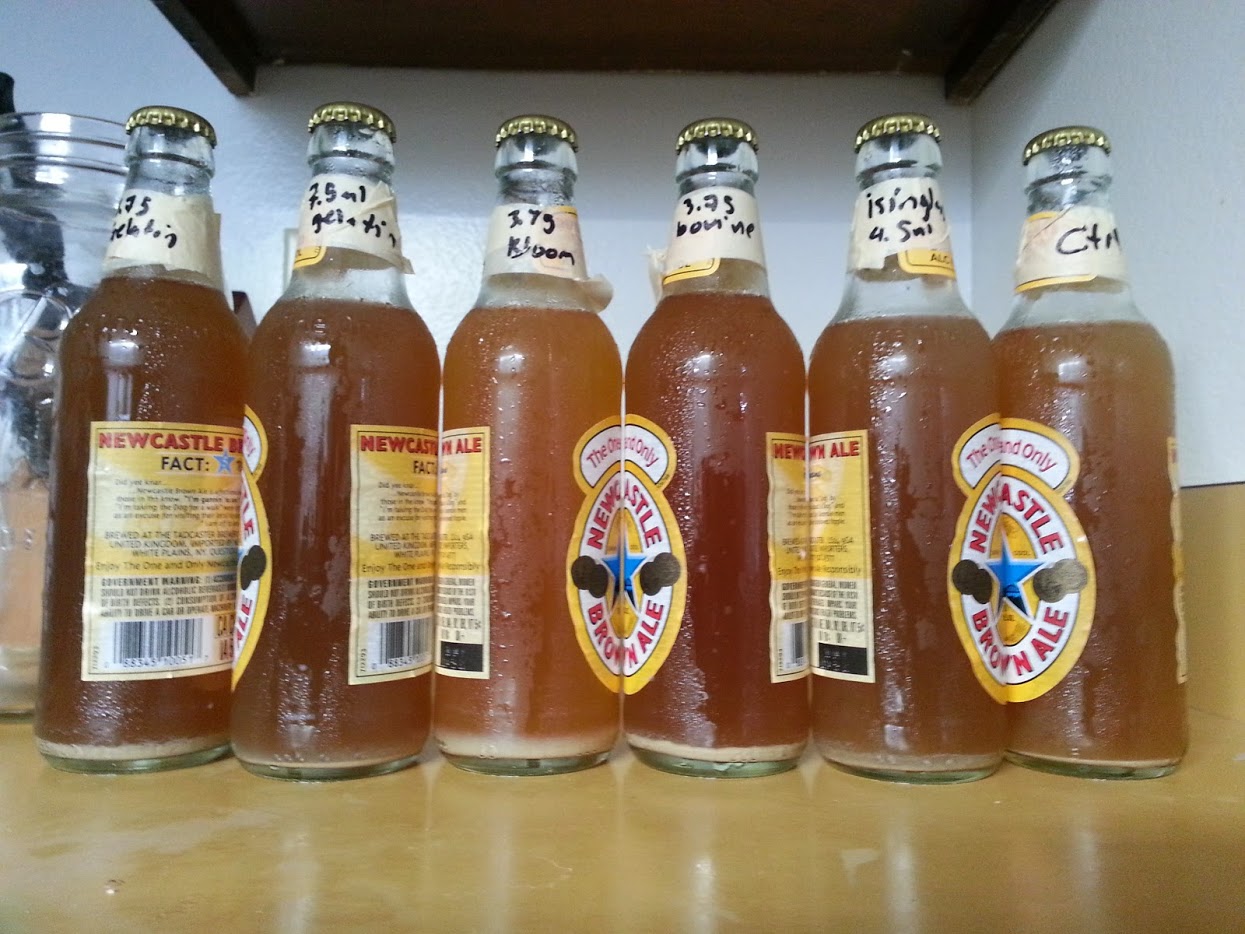Made a cloudy pale ale a few weeks ago so I thought I'd use it to experiment with finings.
I tried 2 different types of gelatin, the first one is the standard unflavored knox knockoff (kroger). This stuff smells like crap, so I got some 100% bovine gelatin off amazon which smells much better.
For both types of gelatin I used the standard method of mixing 1tsp gelatin with 150ml water and immediately using the microwave to heat it in bursts up to 150 degrees.
I've also read some recommend letting gelatin "bloom" by leaving it in lukewarm water for 30 minutes first, so I tried that as well with the kroger gelatin. I really doubt this did anything.
I added 3.75ml of gelatin mixture to each bottle, except for one that I added 7.5ml of the kroger quick heated version.
As for the Isinglass, I got the powdered kind from Williams brewing because it is shelf stable. Since you have to mix it thoroughly and I didn't want to oxygenate it, I added the isinglass to a bottle of bud lite. I shook the opened the bud light, added the powder, then shook it a little. This caused the bud light to foam up a little and force some co2 out so I could recap it without having any oxygen trapped inside. I then shook the crap outta the bud light bottle on and off for a half hour.
So to recap, in the pictures below, from left to right we have:
1) 3.75ml kroger gelatin quick heat
2) 7.5ml kroger gelatin quick heat
3) 3.75 ml kroger gelatin, bloomed
4) 3.75ml bovine gelatin quick heat
5) 4ml isinglass
6) Control - nothing added
First picture is on Sunday evening, the second picture is tuesday night, so 2 days later and stored in the refrigerator the whole time.
I'll keep posting updated pics in this thread if people find this interesting. So far I'm not seeing very much clearing from any of the bottles, so I'm thinking maybe finings don't work on certain types of haze. My next batch should be much clearer so I'll probably do the same experiment on that one as well.



I tried 2 different types of gelatin, the first one is the standard unflavored knox knockoff (kroger). This stuff smells like crap, so I got some 100% bovine gelatin off amazon which smells much better.
For both types of gelatin I used the standard method of mixing 1tsp gelatin with 150ml water and immediately using the microwave to heat it in bursts up to 150 degrees.
I've also read some recommend letting gelatin "bloom" by leaving it in lukewarm water for 30 minutes first, so I tried that as well with the kroger gelatin. I really doubt this did anything.
I added 3.75ml of gelatin mixture to each bottle, except for one that I added 7.5ml of the kroger quick heated version.
As for the Isinglass, I got the powdered kind from Williams brewing because it is shelf stable. Since you have to mix it thoroughly and I didn't want to oxygenate it, I added the isinglass to a bottle of bud lite. I shook the opened the bud light, added the powder, then shook it a little. This caused the bud light to foam up a little and force some co2 out so I could recap it without having any oxygen trapped inside. I then shook the crap outta the bud light bottle on and off for a half hour.
So to recap, in the pictures below, from left to right we have:
1) 3.75ml kroger gelatin quick heat
2) 7.5ml kroger gelatin quick heat
3) 3.75 ml kroger gelatin, bloomed
4) 3.75ml bovine gelatin quick heat
5) 4ml isinglass
6) Control - nothing added
First picture is on Sunday evening, the second picture is tuesday night, so 2 days later and stored in the refrigerator the whole time.
I'll keep posting updated pics in this thread if people find this interesting. So far I'm not seeing very much clearing from any of the bottles, so I'm thinking maybe finings don't work on certain types of haze. My next batch should be much clearer so I'll probably do the same experiment on that one as well.







